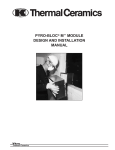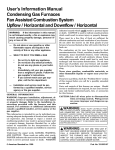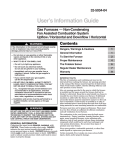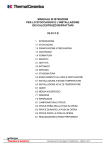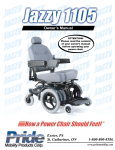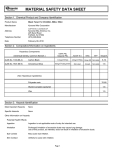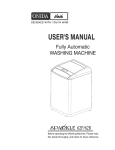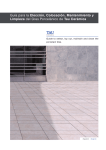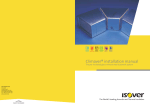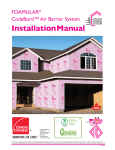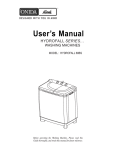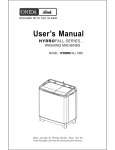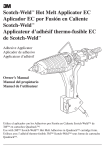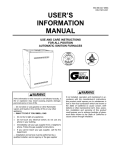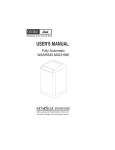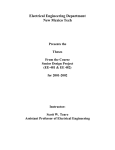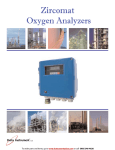Download English UK - Morgan Thermal Ceramics
Transcript
PYRO-FOLD® M™ MODULE DESIGN AND INSTALLATION MANUAL Thermal Ceramics TABLE OF CONTENTS A. Preface Introduction B. Pyro-Fold M Module 1. General 1.1 Lining Considerations 1.2 Site Preparation 1.3 Stud Welding Equipment 2. Installation C. Glossary of terms 3 4 6 6 9 12 List of Figures Figure 1 Pyro-Fold M Module with Stud Gun and Control Box Figure 2 Pyro-Fold M Module Cutaway Displaying Internal Anchoring as well as Stud and Nut Figure 3 Pyro-Fold M Module with Anchor Hardware and Installation Equipment Figure 4 Typical Pyro-Fold M Module Lining Figure 5 Typical Installation using Soldier Course Pattern with Batten Strip Figure 6 Inserting Packing Pin into Batten Strip Overhead Figure 7 Folded Module Cutting Detail Figure 8 Pyro-Fold M T-Bar Module Corner Block Figure 9 Equipment Set-Up with Separate Power Source and Control Box Figure 10 Equipment Set-up with Power Source and Control Box Combined Figure 11 The Welding Process Figure 12 Portable Stud Gun Figure 13 Weld Inspection Figure 14 Bend Test List of Tables Table 1 Typical Welding Conditions for Stud Welding of Steel Figure 1 - Pyro-Fold Y Module, Stud Gun and Control Box Page 2 Thermal Ceramics 2 3 4 4 5 5 6 7 8 8 DESIGN & INSTALLATION MANUAL PYRO-FOLD M MODULE INTRODUCTION PYRO-FOLD M MODULE Over the past 80 years, Thermal Ceramics has proven itself to be a world leader in solving problems for heatintensive industries. The Pyro-Fold M Module is a folded module system designed for industrial applications that require corrosion barriers, a back-up blanket layer or a pre-layed-out stud system. The Pyro-Fold M Module is composed of ceramic fiber blanket accordion folded to form the module. The folded blanket is precompressed in one direction and banded. The anchor hardware consists of an internal M yoke in the center of the module and two support tubes. The Pyro-Fold M Modules are available in 8# pcf and 9.3# pcf densities (128 and 149 kg/m3) and in thicknesses from 4 to 12 inches (102 to 305 mm). These modules can also be made using any of our standard blanket chemistries to suit the particular furnace application, i.e., Kaowool® S, Cerablanket ®, Cerachem ® and ® Cerachrome . The internal anchor hardware is made of 304SS. The necessary studs, nuts and installation tools are purchased separately. The refractory ceramic fiber manufactured by Thermal Ceramics is a highly versatile material. It can be spun or blown into bulk, air-laid into a blanket, folded into modules, formed into monolithic modules (Pyro-Bloc ®), converted into boards and shapes, die-cut into gaskets, twisted into yarns, woven into rope and cloth, and blended into liquid binders for coatings and cements. With this wide range of products, Thermal Ceramics can provide exactly the right product, or engineered system to fit your requirements. Thermal Ceramics has an experienced staff of refractory specialists to assist you in product selection, system design, and installation techniques. Thermal Ceramics has enjoyed great success with its ceramic fiber products due to their cost-effectiveness and excellent insulating properties. They are lightweight and have low thermal conductivities, excellent resistance to thermal shock, outstanding electrical resistivity, and good acoustical properties. This Design and Installation Manual is intended to give the designers, installers, and users of Thermal Ceramics ceramic fiber products a broad range of information on how to select the most appropriate fiber system for a particular application, necessary design criteria, and how to correctly install the selected system. PLEASE NOTE: This manual has been designed to easily accommodate new or revised information. Holders of the manual are advised to keep their address current with the Advertising and Sales Promotion Department at Thermal Ceramics in Augusta, Georgia. Any questions or comments regarding this manual should be addressed to your local Thermal Ceramics representative. Figure 2 - Pyro-Fold M Module Cutaway The installation equipment and tools described in this manual have been developed to ensure a quick, reliable installation. Figure 3 - Pyro-Fold M Module with Anchor Hardware and Installation Equipment December 2002 Thermal Ceramics Page 3 1. GENERAL 1.1 Lining Considerations A Pyro-Fold M Module lining is best installed using a soldier course pattern utilizing a folded batten strip. Figure 4 shows how a typical Pyro-Fold M Module lining would be installed on the walls and roof of a furnace. In high temperature applications, it is best to limit the length of the folded batten strips to 121/2 feet in order to minimize the effect of shrinkage. The ends of the batten strips should be tightly compressed into the adjoining batten strip or preferably shiplapped as in Figure 5. In overhead applications, the folded batten strip must also be pinned to the modules using the Thermal Ceramics T/C-403 packing pin. It is important to insert this packing pin on an angle as shown in Figure 6 in order to ensure the legs of the packing pin do not fall in the fold of a module. Prior to installing the Pyro-Fold M Modules, it is necessary to lay out the necessary stud pattern and weld the studs in place. At this point, a stalastic coating can be applied to the steel casing followed by a layer of blanket for back-up as well as a layer of stainless steel foil for a vapor barrier if required. The specific operating conditions for your particular furnace will determine the need for stalastic coatings, back-up blanket and vapor barriers. Figure 4 - Typical Pyro-Fold M Module Lining Once the studs and back-up materials are in place, the Pyro-Fold M Modules can be installed. The yoke in the Pyro-Fold M Module has an offset to allow for the stud to be in the center of the module. Figure 5 - Typical Installation Using Soldier Course Pattern with Batten Strip Page 4 Thermal Ceramics Figure 6 - Inserting Packing Pin into Batten Strip Overhead DESIGN & INSTALLATION MANUAL PYRO-FOLD M MODULE The Pyro-Fold M Module can be cut or trimmed to allow for obstructions such as burners or peepsites. Best results will be achieved if the module is trimmed equally from opposite sides of the module, so that the stud will remain centered as closely as possible. This point is outlined in the cutting detail in Figure 7. It is best to cut less than what is necessary and compress the module into place to ensure the tightest possible joint. 1.2 Site Preparation The steel surface to be lined should be free of heavy rust or scale, non-conductive paints, dried refractory cements or oil. Sandblasting, wire brushing or grinding will be required to clean the surface, or at least the area where the stud is to be attached. Set up good scaffolding so there will be easy access to the areas to be lined. Also, make arrangements for the material to be as close to the work area as possible without being in the way, so it can be efficiently delivered to the work crews. The steel shell should preferably be 10 gage or thicker. This will minimize difficulty with blowing holes in the steel while trying to weld the studs in place. 1.3 Stud Welding The process of arc stud welding involves the same principles as any other arc welding process. 1) Creation of welding heat by developing an arc between the stud and the plate. 2) Bringing the two pieces together when the proper temperature is reached. Figure 7 - Typical Pyro-Fold M Cutting Detail Bullnose areas present a challenge for folded module systems. These areas are best accommodated by utilizing a Pyro-Fold M T-Bar corner block as shown in Figure 8 or a stacked module of similar configuration. These corner block modules can be specially designed to match the specific requirements of the furnace. The equipment needed includes a stud gun, a control unit and an adequate DC welding current supply. The stud is loaded into the properly sized chuck, the ceramic ferrule is placed in position over the end of the stud and the gun is properly positioned for welding. The gun, control unit and welding machine are connected as shown in Figure 9 or 10 for welding. Figure 8 - Typical Pyro-Fold M T-Bar Corner Block Figure 9 - Equipment Setup with Separate Power Source and Control Box December 2002 Thermal Ceramics Page 5 Figure 10 - Equipment Set-up With Power Source and Control Box Combined Figure 12 - Portable Stud Gun The welding process is shown in Figure 11. A solenoid coil within the gun is energized when the trigger is pulled. This lifts the stud off the plate and creates an arc. The end of the stud and the plate are melted by the arc. Upon completion of the preset arc period, the welding current is automatically shut off. The mainspring within the gun then plunges the stud into the molten pool on the plate to complete the weld. The gun should then be lifted off the stud and the ferrule broken off. To set up the gun for shooting studs, set the plunge length to approximately 1/8 inch (3.2mm) (Figure 12). The approximate settings for weld time and weld current is provided in Table 1. STUD Weld Base Diameter (in.) (mm) Weld Time (Cycles)* Weld Current (Amperes) /4 6.4 10 400 /16 7.9 15 500 3 /8 9.5 20 550 7 /16 11.1 25 675 1 /2 12.7 30 800 *60 cycles = 1 second The above settings may vary due to the power source, condition of the work piece, age of equipment, length of cable used between power source and the control unit and the alloy to be used. After determination of proper settings, the unit is ready to weld studs. 1 5 Installation rates for welding studs in this manner will vary with the size of the stud and other working conditions. However, an average rate is approximately six studs per minute. Table 1 - Typical Welding Conditions for Stud Welding of Steel (A) Gun is properly positioned. (B) Trigger is depressed and stud is lifted, creating an arc. (C) Arcing period is completed, and stud is plunged into the molten pool of metal on the base metal. (D) Gun is withdrawn from the welded stud, and ferrule is removed. Figure 11 - The Welding Process Page 6 Thermal Ceramics DESIGN & INSTALLATION MANUAL PYRO-FOLD M MODULE The most common method for testing the welds is the bend test. This is carried out by striking the stud with a hammer or by using a bending tool such as a pipe (Figure 14). In the case of a good weld, the stud will break before the weld. In either case, the testing will damage the stud, so shoot the test studs on a separate plate or be prepared to grind smooth the area and reshoot. Figure 14 - Bend Test As with any welding process, the operator should understand the process, properly maintain the equipment and follow proper safety precautions. (A) Good stud weld with a good flash formation (B) Stud wel in which plunge is too short (C) Hang-up (D) Poor alignment (E) Stud weld made with insufficient heat (F) Stud weld made with excessive heat Figure 13 - Weld Inspection (Good and Bad Welds) December 2002 Thermal Ceramics Page 7 2. INSTALLATION The Pyro-Fold M Modules are typically installed soldier course with a folded batten strip between rows. The PyroFold M Module requires a pre-layed-out stud pattern so the first step is to establish the layout. Step 3 Step 1 Measure the correct distance vertically and horizontally and mark with a chalk line. Typically, for walls the stud spacing is horizontally 12" (305mm) and 13 1/2" (343mm) vertically. Install the plastic covers over the studs and coat the steel casing with stalastic. If a coating is not being used, plastic covers for the studs are not needed. At this point, back-up layers of blanket and stainless steel foil vapor barriers should be installed if being incorporated into the lining of the furnace. Step 4 Step 2 At the points where the chalk lines cross, weld an M Module two step stud onto the steel casing. Page 8 To install the Pyro-Fold M Module, insert the guide rod through the hole in the yoke tab, lift the module and guide rod into position and thread the guide rod onto the small tip on the M Module stud. The module can now be pushed into place with the module yoke tab sliding onto the stud and against the steel casing. A slide plate can be used against adjoining modules to ease the installation. Thermal Ceramics DESIGN & INSTALLATION MANUAL PYRO-FOLD M MODULE Step 5 Step 8 Insert a hexnut into the end of the nut driver and slide onto the guide rod. Thread the nut by hand onto the stud. Remove the guide rod. Lay folded batten strip in place on top of installed row of modules before installing the next row of modules. Step 6 Using a ratchet or drill, tighten the nut onto the stud. Step 9 When all the Pyro-Fold M Modules have been installed, the banding strips should be cut and removed. Step 7 Push the fiber together to eliminate the hole in the center of the module. December 2002 Thermal Ceramics Page 9 Step 10 The final step should be to tamp out the lining, to further tighten all joints and close any gaps that may exist. Notice: Some of the products described in this literature contain Refractory Ceramic Fiber (RCF) and/or crystalline silica (cristobalite or quartz). Based on experimental animal data, the International Agency for Research on Cancer (IARC) has classified RCF, along with fibrous glasswool and mineral wool, as a possible human carcinogen (Group2B) and respirable crystalline silica as a probable human carcinogen (Group 2A). To reduce the potential risk of health effects, Thermal Ceramics recommends engineering controls and safe work practices be followed by product users. Contact the Thermal Ceramics Product Stewardship Group (1-800722-5681) to request detailed information contained in its MSDSs and product literature and videos. Page 10 Thermal Ceramics CERAMIC FIBER SYSTEMS: DESIGN & INSTALLATION MANUAL GLOSSARY OF TERMS Amorphous: Having no definite crystalline structure or form. Back-up Insulating Material: The layer or layers of insulating material that are located between the hot face insulating layer and the outer casing. Blanket: A flexible unbonded ceramic fibrous insulating material of reasonably determinate dimensions. Board: A substantially rigid or semi-rigid flat sheet produced by vacuum forming. Lock Washers: Washers used in conjunction with Kao-Lok studs. They are slotted so that when pushed over the stud and then twisted 90° the washer is locked into place, other locking systems are available, such as cone anchors. Lock anchors come in ceramics or alloy metals to suit temperature requirements. Maximum Temperature Rating: The temperature which is used by the industry as a loose classification of different grades of ceramic fiber. This is generally higher than the continuous use limit. Bulk Fiber: Ceramic fibers in the “as-produced” state. Module: A prefabricated unit which can be applied as a lining block to the inner face of a furnace structure. Butt Joint: A ceramic fiber wallpaper construction joint where edges of adjacent blankets meet. Mortar/Cement: A ceramic-based adhesive for attaching ceramic fiber products to other surfaces. Cold Face Temperature: Term used to denote the outside casing temperature. Mullite: A crystalline phase of alumina-silica. Continuous Use Limit: Long-term (continuous) temperature limit for a product installed as a lining. This temperature is based upon product shrinkage, specifically what is considered to be a “manageable” or “controllable” shrinkage. This term is not to be confused with temperature rating. Cristobalite: A crystalline phase of silica which will begin to form above 1800°F. Devitrification: The phase transformation from glass to crystalline structure. Edge-grain: The orientation of a fiber system in which strips of ceramic fiber blanket or felt are oriented perpendicular to the plane of the furnace casing. Felt (Pressed): A flexible sheet product formed from ceramic fibers and bonded with an organic binder. Heat Loss: The term used to denote the amount of heat being lost through a lining construction over time, measured in BTU/sq ft/min, (watts/sq in). Heat Storage: The thermal property of a material wherein heat accumulates in the mass (which in refractories is a function primarily of the material’s specific heat, mass, and temperature rise measured in Btu/lb/°F (Cal/g/°C). Heat Transfer: The study of heat flow mechanisms - conduction, convection, and radiation. High Alumina Fiber: A ceramic fiber containing more than 90% alumina, giving a high use limit. Mullite fiber is also used in high temperature applications. High Purity (HP) Fiber: A ceramic fiber produced from synthetic alumina and silica. Hot Face Insulating Material: The layer of lining insulating material that has at least one surface exposed to the full temperature of the furnace gases. Kaolin Fiber: A ceramic fiber produced from calcined kaolin. Laminar Flow: The flow of a gas in which the gas stream moves in straight lines parallel to the direction of the flow. Layered Lining Wallpaper: Lining that is composed of several layers and thicknesses of refractory ceramic fiber. Linear Shrinkage: The amount of shrinkage which occurs along the length of a material after it has been subjected to elevated temperatures and then cooled - measured in percent of original prefired length. December 2002 Overlap Construction: A construction technique used to accommodate shrinkage in ceramic fiber or to improve velocity resistance in which one edge of a blanket is lapped over an adjacent blanket edge by 4" to 12" and shares a common anchor stud and washer. Paper: A roll product produced from ceramic fibers and organic binders on conventional paper-making machinery. Parquet: A method of installing modular edge-grained forms of ceramic fiber so that the edge grain of one module is perpendicular to the edge grain of the adjacent modules. Rigidizing: The practice of applying an inorganic hardening agent to the surface of ceramic fiber (by spray or brush) in order to improve its velocity resistance. RCF: Refractory Ceramic Fiber. Shingled Joint: A method of applying double layers of ceramic fiber blanket in such a way that half the width of each layer overlaps half the width of the adjacent layer. Shot: A glassy material formed during fiberization. Textile: Cloth, tape, sleeving, tubing, or other forms manufactured from ceramic fiber yarn. Thermal Conductivity: The property of material to conduct heat measured in Btu flow per hour through a square foot of area across one inch of thickness Btu•in/hr•ft•°F (w/m •C°). Thermal Resistivity: The property of a material to resist the flow of heat; the reciprocal of thermal conductivity. Thermal Shock: A failure mechanism wherein sudden changes in temperature bring sufficient thermal mechanical stress in a material to cause cracking or spalling. As a general rule, the thermal shock resistance of a material is greater as the strength and thermal conductivity of a material increase and as the thermal expansion and modulus of elasticity decrease. Turbulent Flow: Fluid flow in which the velocity of a given stream of gas changes constantly both in magnitude and direction. Vacuum Forming: A method of producing molded shapes and flat board by converting fibers into a slurry and vacuuming them onto a screen former. Veneer: Layer of ceramic fiber in either blanket or module form which is attached to the hot face of a brick, module or monolithic lining. Wallpaper Construction: The term used to describe a ceramic fiber lining construction technique where the blanket is installed on a wall like a roll of wallpaper. Thermal Ceramics Page 11 For further information, contact your nearest Thermal Ceramics technical sales office, e-mail [email protected] or visit us on the web at www.thermalceramics.com. Global Headquarters Thermal Ceramics Global L'Européen - Bât. C 2, rue Joseph Monier 92859 Rueil-Malmaison Cedex, France T: +33 (0)1 47 16 22 23 F: +33 (0)1 47 16 22 40 E-mail: [email protected] Global Marketing Offices Thermal Ceramics Americas 2102 Old Savannah Road Augusta • Georgia • 30906 T: +1 (706) 796 4200 F: +1 (706) 796 4398 E-Mail: [email protected] Thermal Ceramics Asia Pacific 28 Jalan Kilang Barat Kewalram House Singapore • 159362 T: +65 6273 1351 F: +65 6273 0165 E-mail: [email protected] Thermal Ceramics Europe Tebay Road • Bromborough • Wirral CH62 3PH • England T: +44 (0) 151 334 4030 F: +44 (0) 151 334 1684 E-mail: [email protected] Sales and Marketing Office Locations North America - Sales Offices Canada T: +1 (905) 335 3414 F: +1 (905) 335 5145 Mexico T: +52 (555) 576 6622 F: +52 (555) 576 3060 United States of America Eastern Region T: +1 (800) 338 9284 F: +1 (866) 785 2764 Western Region T: +1 (866) 785 2738 F: +1 (866) 785 2760 South America Argentina T: +54 (11) 4373 4439 F: +54 (11) 4372 3331 Brazil T: +55 (21) 2418 1366 F: +55 (21) 2418 1205 Chile T: +56 (2) 854 1064 F: +56 (2) 854 1952 Colombia T: +57 (2) 2282935/2282803 F: +57 (2) 2282935/2282803 Guatemala T: +50 (2) 4733 295/6 F: +50 (2) 4730 601 Venezuela T: +58 (241) 878 3164 F: +58 (241) 878 6712 www.thermalceramics.com 12.02/M144 COPYRIGHT © 2002 THERMAL CERAMICS INC.












